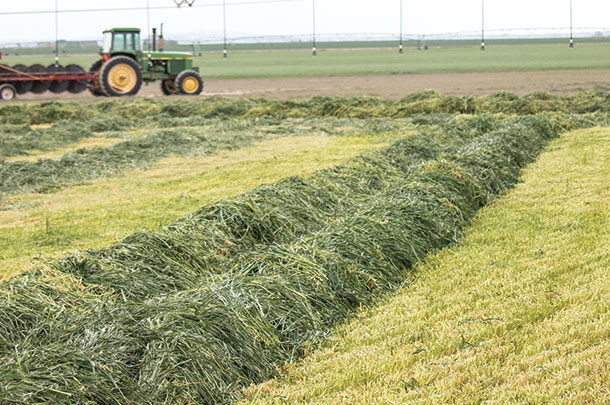Farmers have the double challenge of raising forages for their businesses and livelihoods as well as preventing ecological disasters through the misuse or overuse of growing those forages. It’s important that farmers reduce and eliminate monoculture farming by incorporating alternative forages into the crop rotation.
Selecting alternative forages and rotating them into a farm’s cropping schedule will improve the overall farm income stream, as more forage is grown annually on a farm. It also has the added benefit of restoring the soil health through more polyculture – rather than monoculture – farming.
As they grow forages for livestock, farmers must find the optimal combination of forages that are profitable and economically feasible to grow while keeping the soil healthy. The combination of forages best suited for any farm is dependent upon a number of factors, including weather and livestock nutritional requirements as well as soil type and nutrient management needs.
Many different forages are grown around the world for animals’ nutritional needs. Grasses, grains and legumes are the primary staple forages. Corn has become the king of all forages, providing more calories per acre than any other.
Alfalfa has been the king of protein forages for decades. However, alfalfa does not grow well in all parts of the country. Grasses such as timothy, fescue and orchardgrass are grown in locales where growing legumes can be a challenge.
Forages can be grouped into three general categories: warm-season forages (annuals such as corn and sorghum), cool-season forages (annuals such as oats, ryegrass and triticale) and perennials (legumes such as alfalfa and clover, and grasses such as orchardgrass, timothy and fescue).
In many areas of the country, especially where the growing season is short, farmers have traditionally grown only a single grain crop, such as corn, and let the ground lay fallow during the winter. In recent years, more farmers are recognizing the value of double-cropping and getting an additional grain or grass forage off of a field to increase the forage inventory on the farm.
While many farmers with livestock will continue growing corn as their primary forage, with a little experimentation and extra management, they can significantly increase the tonnage per acre by planting cool-season forages.
According to Connecticut producer Louis Lipton, the types of forages grown on a farm vary from year to year, largely depending on the weather and the needs of the farm. There is no fixed standard for the different crops that can or should be grown in any given year.
A lot of the decision is deduced through trial-and-error and learning what forages do well under different conditions as well as the weather and soil conditions.
Lipton says in a year like this, where milk prices are down for dairy farmers, the more forages they can grow on their own property, the better off they will be. It’s really important in the tough years, where grain markets are volatile and the demand for high-quality forage increases, that farmers try to grow more forages and that they be willing to experiment with different crops at different times of the year to see which ones are the most productive.
In northern Connecticut, Louis and his brother, Jake, farm several hundred acres, growing a variety of different forages that are either baled or ensiled for dairies and other livestock operations in southern New England.
As an example, Lipton says, if he were to get a field of small grains such as rye or wheat (that had been planted the previous fall) combined late in July or early August for grain, he then must make a calculated decision, depending on the soil moisture and expected upcoming weather, as to whether he would plant sorghum, sudan or wait a few weeks to plant oats.
Sorghum or sudan are summer crops and require much warmer weather to grow and get a good yield. If August cooled down, which it sometimes does, planting oats would be a better choice because the oats grow better in cooler weather.
There’s some risk involved in deciding which forage to plant. Both the sudan and oats would be ensiled or put into round bales, but oats would be chopped several weeks later.
One of the challenges with growing winter forages in New England is the harsh winters. Triticale, a wheat-rye hybrid, is an up-and-coming alternative forage Lipton is having good luck with in standing up to the extreme cold and surviving into the spring.
Triticale must be planted by the end of September and chopped at the beginning of May, providing alternative forage for heifers and dry cows and enabling a dairy farmer to stretch his corn inventory. However, planting triticale too early could result in early, unwanted growth that doesn’t overwinter well.
In cases where soils have been severely depleted of nutrients through continuous monoculture or lack of fertilization, alternative forages are needed as cover crops to help restore organic matter to the soil. Annuals such as triticale or oats or a legume like clover should be planted and, rather than being harvested for feed, should be plowed back under when mature.
This may need to be done numerous times to rebuild badly damaged soils. Forage radish – a member of the brassica family – also works well to break up hardpan.
Lipton also uses an oats/annual ryegrass blend, which is planted in September. The oats come up and can be chopped for baleage in the fall. The annual ryegrass overwinters and can be chopped in the spring of the following year or used as a cover crop and turned under to improve soil quality. The farmer then has the option of planting corn or sudan after the winter forage is harvested – again depending on the needs of the farmer.
Though there’s none grown in southern New England, forage sorghum is a high-yielding forage that grows well in very dry conditions. According to Lipton, its tonnage yield to the acre is similar to corn, but it has no grain.
A forage gaining in popularity that can be used for hay is teff grass. It grows well in drier conditions, but it does need adequate soil moisture to germinate in the spring.
The foundation of all farming is the soil and the health of the soil. Farmers should no longer be practicing monoculture farming – planting the same crop on the same field year after year. There is a large selection of alternative forages that can be rotated into production which will provide both good tonnage yields for harvest and good nutrition for livestock as well as maintaining good soil health. ![]()
PHOTO: This fall-planted triticale is ensiled for a dairy herd in early spring, prior to planting corn silage on the same field for fall forage. Photo by Lynn Jaynes.

-
John Hibma
- Consulting Ruminant Nutritionist
- South Windsor, Connecticut
- Email John Hibma













